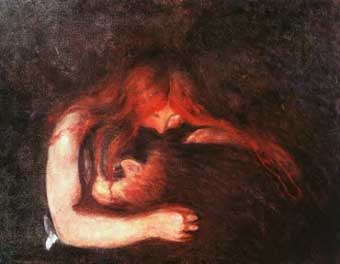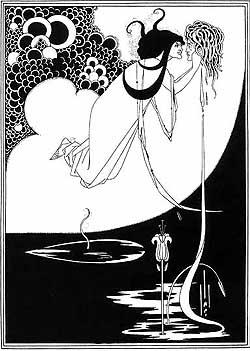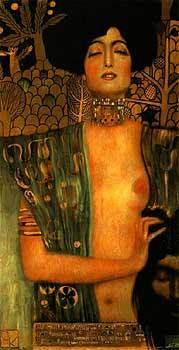Heather Chessman - The Femme
Fatale
|
The image of woman in art and literature as
passive and demure in her setting of domestic tranquility took
a sudden turn late in the nineteenth century. She became self-possessive
and cold. She took pride in her powerful sexuality staring out
at the viewer with great force. Her goal was the destruction
of man. She meant to seduce and consume. Serving as a distraction,
she stole an artist's attention and crushed his ability to create.
What caused this change in the romantic portrayal of woman as
victim to an evil force that sought to ruin men? The femme fatale
became the dominant mode in which to portray women between the
time of the Pre-Raphaelites through the Symbolists to the early
twentieth century.
|
|
Women in the nineteenth century were believed
incapable of understanding art or intellectual activities. They
were mainly confined to the home and domestic activity. Patrick
Babe stated, "The belief was widespread that women sapped
creativity and that they were incapable of elevated feelings
or of understanding art."(Bade 6)
Then things began to change. Women in the late nineteenth century
began to realize their limited role and began to question the
dominance of men over women. Social change was coming for women
and along with this change came man's fear of the power of women
and the effect she had on the minds of men. This was directly
reflected in European culture at the time. Artists began taking
the image of the female heroine and interjecting sexuality and
a cold indifference. Prostitution was also at issue. Sexual
diseases such as syphilis were very common and of which many
artists suffered. This new image of women was directly related
to the fears stimulated by the new role in society women were
assuming. In art Bade asserts, "was a revealing example of
how familiar themes were transformed in late nineteenth century
painting and how most unlikely material was used to express
a neurotic anxiety about women." (Bade
17) The image of women no longer possessed the passive
quality seen in earlier works of art. Cold, proud and sexual
was the new heroine. She border-lined on evil. The femme fatale
was often showed with long flowing hair often taking up the
whole scene, which could serve as a seductive element or as
a deadly trap that could snare her victim.
|

The Vampire by Munch
|
In Munch's The Vampire (1895),
the fiery red hair of the women falls all around the man. It
was her most powerful weapon. Her eyes were filled with mischief
and she was ready to seduce. To show this predatory inclination
of women artists often paired women with animals such as being
entwined in a serpent or the woman's body was often part animal
part human with her breasts and head exposed. An example would
be Fernand Khnopff's painting entitled The Caress
(1896) or Franz von Stuck's Sensuality (1891).
She often took on a monster-like image. Peacock feathers were
also used for their brilliant showy colors and often symbolized
vanity. The images of biblical heroines such as Salome and Judith
are also frequently shown in an erotic manner leaving all their
pious traits behind.
|

The Caress by Khnopff

Salome by Beardsley |

Judith by Klimt
|
|
Aubrey Beardsley's illustrations of Salome
(1893) or Gustav Klimt's version of Judith
(1901) are examples of this new trend to depict confident women,
unashamed of the power of their sexuality. The femme fatale
was depicted as a beautiful creature with an underlying motive
to seduce and to destroy. Bade comments, "From Baudelaire
to Marlene Dietrich is a time-span of more than 75 years. During
this period the cult of the femme fatale spread throughout the
civilized world affecting painting, sculpture, illustration,
the decorative arts, the performing arts, literature"
as well as “both popular and esoteric-fashion and no doubt
the thinking and behavior of ordinary men and women".
These men sensed and expressed the underlying anxieties of the
age, which resulted from profound social changes." (Bade
39)
|
Works Cited
Bade, Patrick. Femme Fatale: Images of Evil and Fascinating
Women. London: Ash and Grant, 1979.
Neret, Gilles. Aubrey Beardsley. New York: Taschen, 1998.
Neret, Gilles. Gustav Klimt. New York: Barnes & Noble, 1996.
back
to 2001 projects
- home - next
|